-

人教版高中英语必修4Working The Land说课稿3篇
Knowledge objectives:(1) to make Ss grasp the usage of words, expressions and sentence structures: statistics, struggle, thanks to, rid of, some patterns for persuasion, the “ing” form as subject and object;(2)to use learnt knowledge to persuade sb.Ability objectives:(1) to develop Ss’ reading skills(skimming, scanning, word guessing);(2) to improve Ss’ speaking, communicating and cooperating skills.Emotional objectives:to make Ss know the contribution of Yuan,and learn his spirit and his simple life time.Teaching important and difficult points:(1) some words, expressions and sentence structures mentioned above;(2)the content of the text;(3)training their reading and speaking skills.Teaching methods: CLT, TBLT,QT.Learning strategies: CLS, QLS, TBLS.Teaching procedures:Step 1 lead-in: (1) teacher plays a piece of recent news from CCTV about the harvest of the super hybrid rice, and ask students whether they know Yuan or not, and talk about him and his contribution.(2)Brain storm: let Ss describe Yuan in their minds including his appearance, his living condition and so on.Step 2 fast reading tasks:(1)teacher introduces Yuan and super hybrid rice(2)make Ss read the text as fast as possible with questions. Such as: what’s the general ideaof this passage? What’s Yuan’ dream? (skimming and scanning skill)Step 3 intensive reading tasks(1)let Ss read the text silently, find topic sentence of each paragraph and draw the difficult sentences and the knowledge what they don’t understand.(words guessing)(2)teacher and Ss talk about the important words, expressions and sentences together, and ask Ss to retell the content of the text.(summarizing and paraphrasing)(3)teacher summarize this part.(4) read again following the courseware.

人教版高中英语必修3The million pound bank note说课稿3篇
在接下来的细读环节,我套用了高考对阅读理解的考查方式设置了5个问题,分别为三个推理判断题,一个细节题和一个主旨大意题。学生需要对文章的内容进行分析、归纳、推理、猜测等高级思维活动才能做出正确的回答。【设计意图】这一过程是对学生进行细读的训练,培养学生获取特定信息和挖掘文章深层次信息的能力。第三环节:Intensive-reading (精读) 15′第三个环节精读,既是最重要的环节,也是突破本课重难点的关键。首先,让学生思考剧本中人物看到百万英镑前后的态度发生了怎样的变化。其次,让学生仔细阅读文章,找出可以表现人物态度变化的具体的语言和动作。最后,让学生总结人物的态度发生变化的根本原因是什么,从而引出Money Talks, 供学生思考。【设计意图】通过一系列的活动培养学生学习从人物的语言和动作探究人物的心理,使学生进一步体会戏剧语言的魅力,从而对文章背后所反映的社会问题进行思考,也为下一步的讨论环节做好铺垫。

人教版高中英语必修5First aid说课稿6篇
In this class, I have 3 teaching aims, that is, knowledge aims, ability aims and emotion aims.1) Knowledge-Teach students new words and expressions, such as temporary, bleed,sprain choke, first aid, fall ill and so on.-Enable students to have a better understanding for some basic knowledge of first aid.2) Ability-Train students’ speaking, reading and writing abilities by different teaching activities, such as skimming, comprehending, team work, role play, retelling and writing.-Develop students’ reading strategy on how to move general idea to specific information.3) Emotion-Promote students’ awareness of giving first aid.- Cultivate students’ creativities.Then let’s come to my teaching methods and activities.III. Teaching methods and activities:To achieve different teaching aims, various kinds of teaching methods and activities will be adopted throughout this period, such as TBL (task-based learning), skimming, team work, brainstorm and others, which can offer students opportunities to fulfill tasks in which they can use language to achieve a specific outcome.IV. Teaching aids:Computer and blackboardV. Teaching important points:1) Make students have a clear mind for the structure of the text.2) Help students understand the theme of the text.VI. Teaching difficulties:1) So many new words may affect students’ understanding.2) How to get students to know about the functions of the skin and thecauses, characteristics and treatments for different degree burns,and the knowledge about giving first aid. VII. Blackboard design:

人教版高中英语必修5Great scientists说课稿4篇
通过写文章梗概,培养学生综合运用语言的能力,学习用恰当的英语描述科学家的故事。这是本课的教学难点。教师可以使用完形填空的方式来帮助学生整理语篇,从而来降低难度。本课的教学重点的突破方法是:在阅读前,让学生初步了解得出科学观点所需要的基本程序,从而轻松而自然地导入文章的阅读;在阅读过程中,由易到难设计快速阅读和精读的问题,层层推进各种阅读活动,让学生对阅读内容从整体感知到细节理解,最后深层读懂整篇文章,同时加强阅读策略的指导,让每个学生都主动参与课堂教学活动,最终达到提高阅读能力的目的。Step 4 Post-readingGroup Activities四人小组共同合作,在老师的适当指导下,就以下2个问题展开讨论,让学生就所知、所学、所感和所想融入话题,然后抽若干同学代表作小组发言。1. What do you think about John Snow, and what should we learn from him?2. Cholera was 19th century disease, which two diseases are similar to cholera today? Why?

人教版高中英语必修5Life in the Future说课稿5篇
Good afternoon, everyone. It’s my great pleasure to be here sharing my lesson with you. The content of my lesson is Senior English for China Book5 Unit 3 Life in the Future. I’ll be ready to begin this lesson from six parts: Analysis of the teaching material, Analysis of the students, Teaching aims and important and difficult points, Teaching methods and aids, Teaching procedures, and Blackboard design. First, let me talk about the teaching material.Part 1 Analysis of the Teaching Material:This unit is about what human beings’ life will be like in about one thousand years. By studying of this unit, we’ll Enable the students to know the changes in humans’ life and some new inventions bringing about the change and develop the interest in science. This lesson plays an important part in the English teaching in this unit. This is an important lesson in Book Five. From this lesson, it starts asking the Ss to grasp contents of each passage. Therefore, this lesson is in the important position of the teaching material. If the Ss can learn it well, it will be helpful to make the Ss learn the rest of this unit.Part 2 Analysis of the SsAs Senior2 Ss, they are at different levels of English fluency, some of them have lost interest in English. So during the lesson, I arrange a variety of activities to let all of them join in to attract their interest and let them be confident and taste the joy of success.

人教版高中英语必修5Making the news说课稿4篇
今天我们来介绍一下必修五第四单元的授课方式。这个单元的题目是Making the news。应该是学生比较感兴趣的话题,学生往往对新闻工作充满好奇,所以我们可以利用这个机会多设计一些师生互动和学生互动,来激发起学习的积极性,提高学习效率。同时我们可以利用这个单元不仅帮助学生掌握语言知识,培养语言能力,同时让其了解新闻工作的重要性,培养起社会智能感。这个单元分为六个课时,它的教学目标是这样的:语言目标是掌握词汇表中的常用单词和短语,掌握倒装句的一些基本用法。 技能目标是能初步掌握约会的基本句型并在真实的场景下正确运用。新闻报道类文章的写作技能。采访的基本规范和沟通技能。情感目标是对新闻报道的客观性和真实性有更好的理解。对新闻记者的职业有更深入的了解,并能体会其工作的重要性。下面我们来介绍一下第一课时的授课方式,第一课的教学目标是这样的第一课时的教学目标语言目标:单词:Occupation, journalist, editor, photographer, curious, personality, enthusiasm

人教版高中英语必修5The United Kingdom说课稿4篇
Teaching Aims:Knowledge 1. Get the students to learn the useful new words and expressions in this section. Aims:2. Let the students learn about how the UK was formed and the four groups of invaders.1. Develop students’ reading ability and let them learn different Ability reading skills. Aims:2. Enable students to learn to talk about the United Kingdom and the Union Jack Emotional 1. Let students know more about the UK2. Develop students’ sense of cooperative learning Aims:Teaching Important Points:1. Let the students learn about the countries of the United Kingdom and the Union Jack2. Get the students to read the passage and know about how the UK was formed and the four groups of invaders.3. Have the students learn different reading skills.Teaching Difficult Ponts:1. Develop students’ reading ability.2. Enable students to talk about the United Kingdom and the Union Jack.3. Let students learn how the UK was formed geographically and historically.Teaching Methods:Showing pictures, asking, exercising, listening, reading etc.Teaching Aids:A computer,a projector and a blackboard.Teaching Procedures: 1) Show a map of the world, ask students the following questions:Where is the UK?What’s the full name of the UK?2) Ask the students work in pairs to do the quiz on Page 9.Do you want to test how many things you know about the United Kingdom? Let’s have a small test.Using the map on P9, students answer the following questions:?How many countries does the UK consist of? What are they??England is divided into three main areas. Do you know what they are? 1) Scanning (10Minutes )Let the students hold the questions asked in pre-reading and read the passagequickly and then let them do the following exercise.Join lines to the right answer.
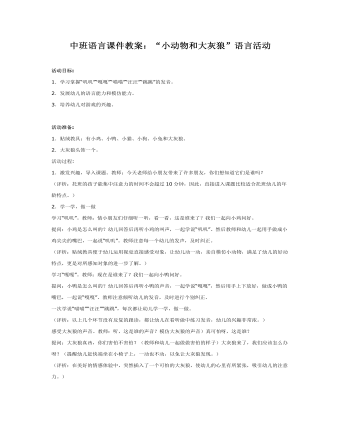
中班语言课件教案:“小动物和大灰狼”语言活动
2.发展幼儿的语言能力和模仿能力。3.培养幼儿对游戏的兴趣。 活动准备:1.贴绒教具:有小鸡、小鸭、小猫、小狗、小兔和大灰狼。2.大灰狼头饰一个。活动过程:1.激发兴趣,导入课题。教师:今天老师给小朋友带来了许多朋友,你们想知道它们是谁吗?(评析:托班的孩子能集中注意力的时间不会超过10分钟,因此,直接进入课题比较适合托班幼儿的年龄特点。)2.学一学,做一做学习“叽叽”。教师:情小朋友们仔细听一听,看一看,这是谁来了?我们一起向小鸡问好。提问:小鸡是怎么叫的?幼儿回答后再听小鸡的叫声,一起学说“叽叽”。然后教师和幼儿一起用手做成小鸡尖尖的嘴巴,一起说“叽叽”。教师注意每一个幼儿的发声,及时纠正。(评析:贴绒教具便于幼儿运用视觉直接感受对象,让幼儿动一动,亲自模仿小动物,满足了幼儿的好动特点,更是对所感知对象的进一步了解。)学习“嘎嘎”。教师:现在是谁来了?我们一起向小鸭问好。提问:小鸭是怎么叫的?幼儿回答后再听小鸭的声音,一起学说“嘎嘎”,然后用手上下放好,做成小鸭的嘴巴,一起说“嘎嘎”。教师注意倾听幼儿的发音,及时进行个别纠正。一次学说“喵喵”“汪汪”“跳跳”,每次都让幼儿学一学,做一做。(评析:以上几个环节没有反复的跟读,都让幼儿在看听做中练习发音,幼儿的兴趣非常浓。)感受大灰狼的声音。教师:听,这是谁的声音?模仿大灰狼的声音)真可怕呀,这是谁?
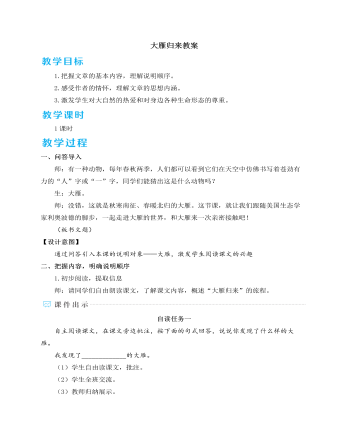
人教部编版语文八年级下册大雁归来教案
2.明确顺序,整合信息(1)根据文章描写的大雁归来的旅程,可以看出本文是按什么说明顺序来写的?提示:抓住时间词、空间词、事物的发展变化的语句来理清结构,判断说明顺序。预设 本文大致是按时间顺序来写的。(2)大雁的行为是如此丰富,作者的观察是这样细致,请同学们分别按不同角度把找到的有关大雁行为的信息分类,看看能发现什么。自读任务二将找到的有关大雁行为的信息,按旅程远近、栖息地、组队、觅食、“集会”与鸣叫等进行分类整理。整理后,你发现了什么?(小组任选一个方面,分类整理,全班交流)预设 示例:旅程远近——直线飞行200英里——坚强、守信;栖息地——沼泽地、池塘边——充满灵性;组队、觅食、“集会”与鸣叫等——具有团结精神,互相关爱。【设计意图】本环节学生自主阅读,获取信息,把握文章写作的顺序;然后整合归纳信息,进而激发学生探讨大雁的兴趣,为后面深入阅读做铺垫。
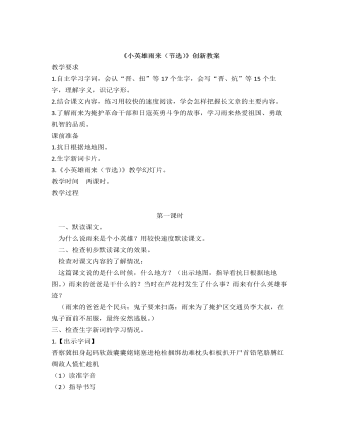
部编人教版四年级下册《小英雄雨来》创新教案
(二)提问:夜校的学习条件怎样?雨来在夜校里受到什么教育?默读第二段。指导朗读:“我们是中国人,我们爱自己的祖国。”“我们——是——中国人,我们——爱——自己的——祖国。”讨论段意和小标题。(段意:雨来上夜校,受到爱国主义教育。)(小标题:“雨来上夜校。”)(三)学习第三段。默读课文,提问:这段主要说了几层意思?学生默读课文,小组交流,展示如下:(两层意思:第一层从“有一天”至“只从街上传来一两声狗叫”,主要写鬼子开始扫荡了;第二层从“第二天”至这段结束,主要写雨来为掩护交通员李大叔,被鬼子捆绑起来了。)指导朗读第二层。重点朗读:“他抬头一看,是李大叔。”“咦!这是什么时候挖的洞呢?”“把缸搬回原地方。你就快到别的院里去,对谁也不许说。”讨论段意和小标题。段意:(雨来为掩护交通员李大叔,被鬼子捆绑起来了。)(小标题:“雨来掩护李大叔”。)
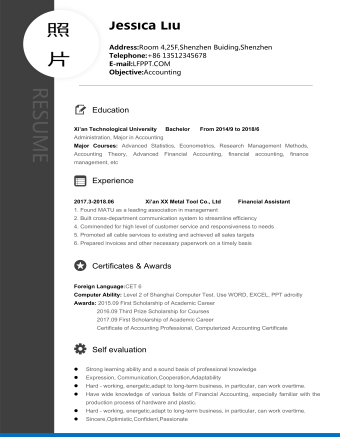
财务人员英文简历
l Strong learning abilityand a sound basis of professional knowledgel Expression,Communication,Cooperation,Adaptabilityl Hard - working,energetic,adapt to long-term business, in particular, can work overtime.l Have wide knowledge ofvarious fields of Financial Accounting, especially familiar with the productionprocess of hardware and plastic.l Hard - working,energetic,adapt to long-term business, in particular, can work overtime.l Sincere,Optimistic,Confident,Passionate
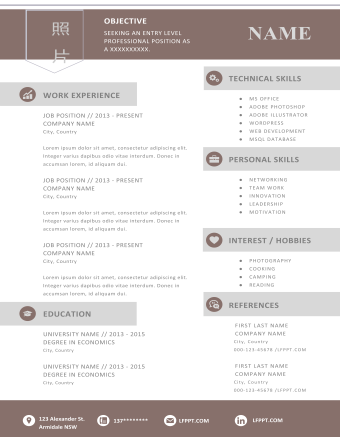
英文简历个人求职模板
WorkexperienceJob Position// 2013 - presentCOMPANY NAMECity, CountryLorem ipsum dolorsit amet, consectetur adipiscing elit. Integer varius dapibus odio vitaeinterdum. Donec in accumsan lorem, id aliquam dui.Job Position// 2013 - presentCOMPANY NAMECity, CountryLorem ipsum dolorsit amet, consectetur adipiscing elit. Integer varius dapibus odio vitaeinterdum. Donec in accumsan lorem, id aliquam dui.Job Position// 2013 - presentCOMPANY NAMECity, Country
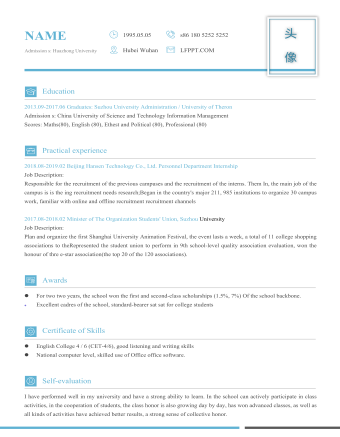
英文简历考研复试配套版
2018.08-2019.02Beijing HansenTechnology Co., Ltd. Personnel Department InternshipJob Description:Responsible for the recruitment of theprevious campuses and the recruitment of the interns. Them In, the main job ofthe campus is is the ing recruitment needs research;Began in the country'smajor 211, 985 institutions to organize 30 campus work, familiar with onlineand offline recruitment recruitment channels2017.08-2018.02Minister of The Organization Students' Union,SuzhouUniversityJob Description:Plan and organize the first ShanghaiUniversity Animation Festival, the event lasts a week, a total of 11 collegeshopping associations to theRepresented the student union to perform in 9thschool-level quality association evaluation, won the honour of thre e-starassociation(the top 20 of the 120 associations).
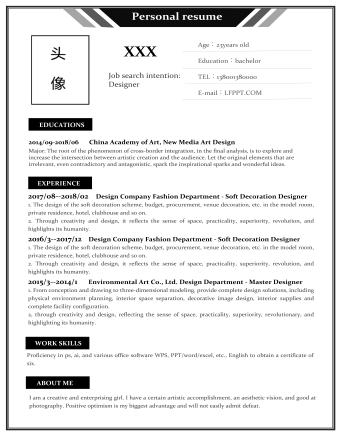
黑白简约英文简历
2017/08--2018/02 Design Company Fashion Department - SoftDecoration Designer1. The design ofthe soft decoration scheme, budget, procurement, venue decoration, etc. in themodel room, private residence, hotel, clubhouse and so on.2. Throughcreativity and design, it reflects the sense of space, practicality,superiority, revolution, and highlights its humanity.2016/3--2017/12 Design Company Fashion Department - SoftDecoration Designer1. The design ofthe soft decoration scheme, budget, procurement, venue decoration, etc. in themodel room, private residence, hotel, clubhouse and so on.2. Throughcreativity and design, it reflects the sense of space, practicality,superiority, revolution, and highlights its humanity.2015/3--2014/1 Environmental Art Co., Ltd. Design Department- Master Designer1. Fromconception and drawing to three-dimensional modeling, provide complete designsolutions, including physical environment planning, interior space separation,decorative image design, interior supplies and complete facility configuration.2, throughcreativity and design, reflecting the sense of space, practicality,superiority, revolutionary, and highlighting its humanity.
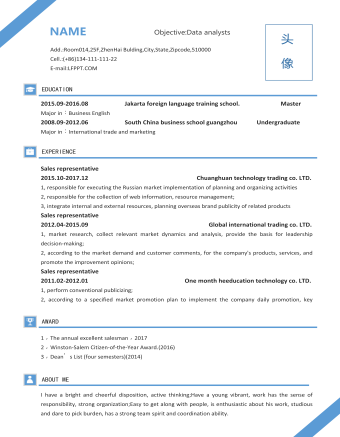
英文简历(简洁版)
Sales representative2015.10-2017.12 Chuanghuantechnology trading co. LTD.1, responsible for executing the Russian market implementation of planningand organizing activities2, responsible for the collection of web information, resource management;3, integrate internal and external resources, planning overseas brandpublicity of related productsSales representative2012.04-2015.09 Globalinternational trading co. LTD.1, market research, collect relevant market dynamics and analysis, providethe basis for leadership decision-making;2, according to the market demand and customer comments, for the company'sproducts, services, and promote the improvement opinions;Sales representative2011.02-2012.01 Onemonth heeducation technology co. LTD.1, perform conventional publicizing;2, according to a specified market promotion plan to implement the companydaily promotion, key projects, cooperation projects, product release PRplanning and execution
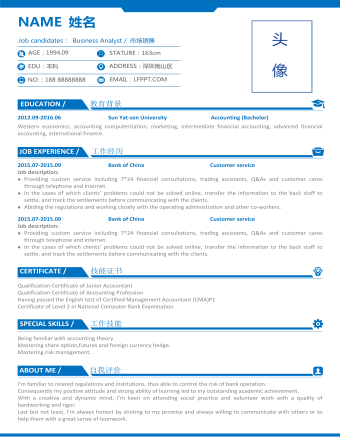
市场营销英文简历
2015.07-2015.09 Bank of China Customer service Job description:lProviding custom service including 7*24 financialconsultations, trading assistants, Q&As and customer cares throughtelephone and internet.lIn the cases of which clients’ problems could not be solvedonline, transfer the information to the back staff to settle, and track thesettlements before communicating with the clients.lAbiding the regulations and working closely with theoperating administration and other co-workers.2015.07-2015.09 Bank of China Customer service Job description:lProviding custom service including 7*24 financialconsultations, trading assistants, Q&As and customer cares throughtelephone and internet.lIn the cases of which clients’ problems could not be solvedonline, transfer the information to the back staff to settle, and track thesettlements before communicating with the clients.
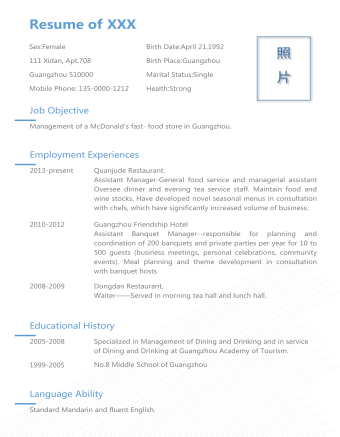
单页简洁英文简历
Guangzhou Friendship HotelAssistant Banquet Manager--responsible for planning and coordination of200 banquets and private parties per year for 10 to 500 guests (businessmeetings, personal celebrations, community events). Meal planning and themedevelopment in consultation with banquet hosts。Dongdan Restaurant.Waiter——Served in morningtea hall and lunch hall.
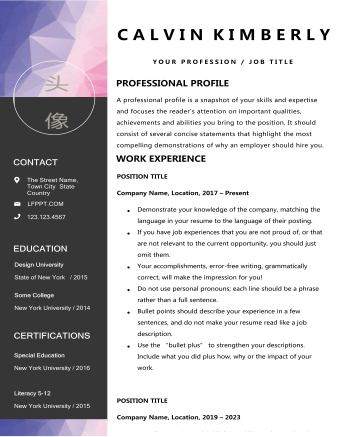
创意英文简历求职模板
POSITIONTITLE CompanyName, Location, 2017– Present· Demonstrate your knowledge of thecompany, matching the language in your resume to the language of their posting.· If you have job experiences thatyou are not proud of, or that are not relevant to the current opportunity, youshould just omit them.· Your accomplishments, error-freewriting, grammatically correct, will make the impression for you!· Do not use personal pronouns; eachline should be a phrase rather than a full sentence.· Bullet points should describe yourexperience in a few sentences, and do not make your resume read like a jobdescription.· Use the “bullet plus” tostrengthen your descriptions. Include what you did plus how, why or the impactof your work.
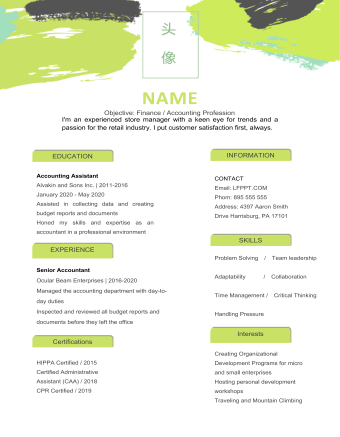
金融会计创意风英文简历
AccountingAssistantAlvakin and Sons Inc. | 2011-2016January 2020 - May 2020Assisted in collecting data and creating budgetreports and documentsHoned my skills and expertise as an accountant ina professional environmentSenior AccountantOcular BeamEnterprises | 2016-2020Managed theaccounting department with day-to-day dutiesInspected andreviewed all budget reports and documents before they left the office
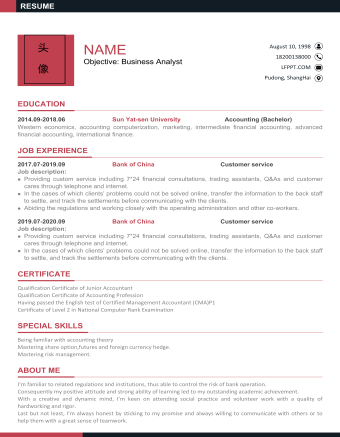
简约证券金融英文简历
2017.07-2019.09 Bank of China Customer service Job description:lProviding custom serviceincluding 7*24 financial consultations, trading assistants, Q&As andcustomer cares through telephone and internet.lIn the cases of which clients’problems could not be solved online, transfer the information to the back staffto settle, and track the settlements before communicating with the clients.lAbiding the regulations andworking closely with the operating administration and other co-workers.2019.07-2020.09 Bank of China Customer service Job description:lProviding custom serviceincluding 7*24 financial consultations, trading assistants, Q&As andcustomer cares through telephone and internet.lIn the cases of which clients’problems could not be solved online, transfer the information to the back staffto settle, and track the settlements before communicating with the clients.


